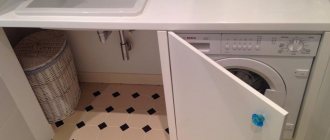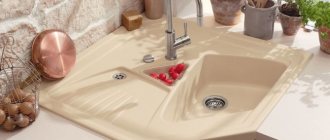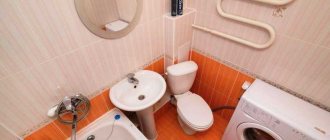It is difficult to imagine modern life without a washing machine: after all, it makes life much easier and saves time. Most often it is installed in the bathroom, but when the bathroom is too small, problems arise with the layout. How will a washing machine feel in the kitchen? Before choosing its final location, let's get acquainted with all the pros and cons of such placement.
Advantages
The most important advantage: the bathroom does not take up precious space, and it becomes freer. But besides this, there are several more advantages that you don’t immediately think about.
Safety
According to fire safety rules, electrical appliances should not be placed in rooms with high humidity, which is the bathroom. The kitchen is a different matter, here the humidity is much lower, and most often there is a window that provides active air circulation.
Work zone
Usually the washing machine is hidden behind the facade or simply covered with a countertop. In both cases, a new work surface appears, which will never be superfluous in the kitchen.
Communications
It is convenient to install the washing machine in the kitchen, since the main communications are already there: both water supply and sewerage - there is no need to install anything additional. You just have to clarify how to connect the electrical wiring, because the machine requires a dedicated line.
Wash anytime
You can do laundry in the kitchen at any time, regardless of whether anyone is taking a bath. On the other hand, noise during spinning and draining can interfere with an evening family meal or watching TV.
But, according to reviews, the same hood is louder than a washing machine. You can run the wash at night: this way the machine will not disturb anyone, and your energy bills will be lower.
What else is worth considering
Of course, it is important to know what the height of the unit is, but this is not enough. There are a number of other aspects to consider. Only then will it be possible to choose the optimal automatic machine. It doesn’t matter whether it will be in the bathroom, kitchen or other room.
Bosch
In any case, in addition to the height of the washing equipment, it is worth considering:
- depth;
- width;
- brand.
Flaws
Everything has both advantages and disadvantages. And the washing machine in the kitchen is no exception. But basically, the disadvantages are not related to the machine itself, but to its “extras”.
Storing dirty laundry
Dirty laundry has an odor, and if you store it in the kitchen, it will also absorb kitchen odors. And this means that it will have to be carried to the kitchen either from the bathroom or from another room. Some people find this very inconvenient - although in fact, there is nothing critical about it.
Storing powder in the kitchen
With powder the situation is more complicated:
- it can be scattered, which is undesirable in the room where food is prepared;
- it gives off a smell that is harmful to breathe.
There are several ways out of this situation:
- store washing powder in another room;
- switch to liquid laundry detergents;
- Store the powder in a container with a good tight lid.
ADVICE. It is most convenient to store the powder in the kitchen either next to the machine or under the sink.
Open door
After washing, the machine door should be opened and the drum ventilated to prevent mold from growing in the appliance. This can interfere with passage, especially if the machine is built-in - after all, you need to open not only the machine door, but also the cabinet door.
Difficulty of change
Once the machine is already installed, it is difficult to move it somewhere else, since pipes and electrical wires are laid. But this applies not only to the kitchen, but also to other rooms.
Spoils the appearance
This does not apply to all washing machines, but only those not hidden behind the facade. Dirty laundry stored inside looks especially unsightly.
ADVICE. To make the machine look neater, you should match it to the kitchen facades, or decorate it with vinyl stickers of the same color.
If both options are not suitable, then the machine is hidden behind a beautiful matching curtain. This is especially true for kitchens in the style of Provence, Country and others.
Review of the best models
When purchasing a washing machine to be built under a countertop, it is important not only to choose the right size, but also to take into account the technical characteristics of the unit. Using the example of several models, we will find out what parameters you should pay attention to:
- Siemens WK 14D540 . Built-in model with dimensions 60 x 60 x 82 cm and loading capacity up to 5 kg. The unit is equipped with a stainless steel tank and 22 washing programs. Fits standard headsets and does not vibrate even at the highest spin speeds. Has leakage protection and imbalance control;
- Zanussi FCS 1020C. A free-standing machine with dimensions 50 x 52 x 67 cm and a loading capacity of up to 3 kg. Easily hides under the countertop, has energy consumption class A and low water consumption (39 l);
- Miele W 2859 iR WPM ED Supertronic. Built-in model with dimensions 60 x 58 x 82 cm and loading capacity up to 5.5 kg. Equipped with 16 washing programs. It is characterized by silent operation, low water consumption (42 l), the presence of a honeycomb drum with illumination and an electricity consumption meter; has energy consumption class A+;
- Bosch WFC 2067 OE . Free-standing equipment with dimensions 60 x 40 x 85 cm and loading capacity up to 4.5 kg. Equipped with 12 washing programs, protection against leaks and a delayed start function; Easily installed under the countertop. It features economical energy consumption;
- LG F-10B8MD . A model with the possibility of embedding, dimensions 60 x 44 x 85 cm and the ability to load up to 5.5 kg of laundry. It has 13 programs, including the “Volume Items” mode, which not all compact models are equipped with;
- Candy Aquamatic 2D1140-07 . Free-standing machine with dimensions 51 x 46 x 70 cm and the ability to load up to 4 kg of laundry. Equipped with a child protection function and 16 washing programs. Ideal for placement not only under the countertop, but also under the sink;
- Bosch WIW 24340 . Built-in model with dimensions 60 x 57 x 82 cm and loading capacity up to 7 kg. Has the highest energy efficiency class - A+++. Equipped with leak protection and 14 washing programs.
Adviсe
There are several ways to reduce the disadvantages of placing a washing machine in the kitchen:
- if it interferes with the meal with its noise, then you can postpone the washing to night time. And it’s best to adjust its legs so that the equipment is installed perfectly level - so it will be practically silent;
- The noise is also affected by the floor covering on which the machine stands. It is worth giving preference to ceramic tiles - the quietest material. But if there is laminate on the floor, then there is a high probability that the neighbors will immediately know when your machine starts spinning the laundry;
- It is best to place the washing machine next to the dishwasher and sink, thus creating a “wet” corner. This makes it more convenient to supply water, and it will be easier to clean when everything is at hand. In a corner kitchen, for ergonomic reasons, the dishwasher is placed to the right of the sink, and the washing machine is placed to the left.
There are several ways to install appliances in the kitchen. They have no significant differences in characteristics, advantages or disadvantages.
Features of placing a washing machine in a kitchen of 6 sq.m.
Soviet architects did not even imagine that decades later household appliances would become an integral part of people's lives. Famous kitchen 6 sq.m. in the so-called Khrushchev buildings requires a lot of imagination in interior design. Therefore, it is very difficult to squeeze a washing machine into such an area. All design tricks to save space are used. After all, in addition to the washing machine, you also need to place a refrigerator, gas stove and other electrical appliances in the room. Optimal options:
- Install the machine in one of the cabinets under the tabletop;
- Place the equipment under the sink;
- Hide the washing machine in a niche under the window, standard for Khrushchev apartments.
Definitely, the machine should be hidden so as not to violate the idea of the interior design and, thereby, not to reduce the already small kitchen area.
Full embedding
A built-in machine in the kitchen is beautiful because it itself is not visible, everything is hidden behind the facades. The unity of style is maintained, the room seems spacious and tidy. This is one of the most common options for installing equipment, but there are several disadvantages :
- the choice of built-in machines is not at all wide;
- the cost of such equipment is significantly higher than standard analogues;
- Difficult to access if repairs are required.
This option is suitable for owners of small kitchens, for example, in Khrushchev-era apartments, when it is necessary to visually expand the space.
Manufacturers of built-in appliances clearly indicate the dimensions of cabinets for installation in their instructions. Below you will find a diagram for installing the Candy CWB 1372DN1-07 washing machine.
And here is a diagram for installing a Whirlpool AWOC 0614 washing machine:
There is a built-in cabinet. This allows you to raise the machine to the desired height, without losing precious space, since there will be storage boxes or other equipment, for example, a microwave oven, under and above it.
↑ Subtleties of installation and care
It is possible to carry out installation work in one day, even with your own hands. An exception would be a tiled stationary concrete countertop. It all depends on the duration of the tiling work.
When planning a joint structure, place communications so as to avoid direct contact of electricity with water.
If the sink is of small depth, make sure that the top of the machine is covered with at least minimal protection from splashes. The bowl itself should protrude 4 cm or more.
Drain pipes and siphons should not touch the washing machine. Fastenings may become loose due to vibration during spin washing. They should not be located directly above the washing machine body. Options for correct placement: on the side (if the sink bowl is on the side); behind the wall.
After installing the siphon and connections, it is worth checking the tightness properly. Cleaning up leaked water in the space behind the washing machine is difficult. The connections from the washing machine should be additionally secured with a clamp.
While using the washing machine, you should regularly check the integrity of the wires, the tightness of connections, hoses, and pipes.
At the installation stage, free access should be provided for cleaning and inspection of connections. No matter how much you would like to install everything as compactly as possible, you shouldn’t push it tightly against the wall. First, condensation can form on the inlet hose, which can lead to mold when it touches the wall. The second reason to freely place all the modules is the vibration of operating equipment, which can lead to disruption of the integrity of the tiles and loosen pipe connections.
Competent calculation of each element and reliable installation guarantee uninterrupted service of this design, which perfectly organizes the interior of even the smallest bathroom.
Partial embedding
If you don’t want to overpay for built-in appliances, you can put a regular front-loading washing machine in the kitchen and cover it with a countertop. Here it is worth considering its height, but the technique is quite standard - about 85 centimeters. The height of a standard tabletop is the same.
If a couple of centimeters are still missing, then you can remove the top cover of the washer: to do this, you need to unscrew a couple of screws on the back - this will give you a few centimeters. But then it is advisable to cover this area with either film or thin plastic.
There are two methods for partial embedding:
- without door;
- with door.
Let's consider these methods in more detail.
Without door
The essence of this arrangement is that the washing machine is simply placed next to the kitchen unit and covered with a countertop. In this case, it is important to attach the tabletop to the wall, and not just lean it on the equipment.
It turns out that the washing machine is closed only at the top, which provides a work area in the kitchen, but the machine is visible from the side. This is a plus, since it’s easier to take out and put down laundry, although aesthetically it doesn’t always look beautiful. This is where the advice of covering the equipment with a curtain, matching it, or decorating it with a vinyl sticker comes in handy.
This arrangement ensures mobility: if the machine breaks down, it’s easy to move it away and then push it back in. Therefore, this method is suitable for those for whom the main priority is convenience rather than beauty.
An example of such embedding can be seen in the photo.
With door
If you want to close the car, then a built-in one with a door is perfect. In principle, there is no actual installation here: the machine is simply placed in the kitchen unit. It is advisable to place it on the floor because the machine may shake. If this is not possible, then you should strengthen the base as much as possible: place bricks or solid wood boards under it, and also reinforce it with corners.
How to properly install and integrate an automatic washing machine under the countertop? Is this even legal?
Of course, you can’t install a standard machine like this, because it won’t fit. It is worth choosing among compact options with a depth of 45–50 cm. Their choice, unfortunately, is as small as that of built-in models, but they are more affordable.
With such an arrangement, you need to watch out for three things :
- a tray for powder - so that it does not rest against the hinges of the door of the unit, but extends out enough to add powder or pour in detergent;
- the location of the door - it is desirable that the car hatch and the door of the set open in one direction, otherwise it will be inconvenient to take out and put down laundry;
- having a margin of 2-3 centimeters on each side to prevent noise from washing.
Moreover, it is advisable to remove the back panel of the headset for air circulation and ventilation of the machine to avoid excess dampness.
Under the sink
Residents of Khrushchev-era apartment buildings sometimes take this step - installing a washing machine under the sink. This may not be the best solution, but in conditions of severe space saving, it has its place.
In this case, you need to pay special attention to the choice of washing machine under the sink:
- the height of the machine should be no more than 70 cm. Otherwise, it will be extremely difficult for small people and children to reach the sink, and they will have to substitute a stool;
- The depth of the washing machine built under the sink should be approximately 50 cm. In this case, it is necessary to take into account the gap behind the rear wall for communications and a flat siphon.
Sinks above the washing machine - Santekhniks.ru
You also need to choose the right sink. It should be a “water lily”, with a maximum height of 20 cm. For safety reasons, the drain should not touch the washing machine.
The advantages of such placement include saving space. Some even consider this layout stylish and modern. However, disadvantages here.
Firstly , these are the disadvantages associated with the small dimensions of the washing machine - neither a down jacket nor a blanket can be washed.
Secondly , the drain in a “lily pad” sink is prone to more frequent blockages.
Thirdly , for installation you will need a special siphon, which is not so easy to find.
Fourthly , there is a risk of water getting on the control board, which will lead to equipment breakdown.
Washing machine in the kitchen
Choosing a washing machine
Today, buyers choose not only functional, but also compact equipment. They initially look at the size of the model, and then at the technical characteristics and features.
Often the choice of SMA depends on how large your room is. For a spacious kitchen, a full-sized machine is perfect, which guarantees ease of use. But it may not fit into the design. If the kitchen is very modest in size, then it is more appropriate to select compact models. Narrow machines will fit even in Khrushchev’s kitchens. It’s easy to hide a “slender” machine in a kitchen unit. Installing the machine under the sink is also suitable. Washing clothes and washing dishes at the same time is a very convenient placement.
If you are accustomed to perfection and unity of style, then the ideal solution is to purchase a built-in machine. You can completely embed the SM, or you can hide it in a furniture set so as not to attract unnecessary attention.
Disguise at the bar counter
In the kitchen-living room it is now fashionable to install bar counters as a zoning element. Most often, there is enough space under them to equip additional shelves.
Give them up in favor of a spacious niche for the washing machine. If you disguise it with doors, it will be invisible to guests. At the same time, the length of the tabletop is quite enough for evening gatherings.
High installation
Connecting the washing machine is not everything. You also need to consider the convenience of subsequent use.
We recommend placing the machine higher up, not on the floor, to make it easier to load things. A good example is in this photo.
This way you won't have to bend over every time you need to wash.
Preparation of communications
The washing machine is connected to three systems: sewerage, water supply and electricity.
Sewerage
There are several varieties possible here:
- Siphon under the sink - you need to install a splitter to the drain running under the sink. It will provide an outlet for the washing machine hose.
- Directly to the sewer - in this case, you will have to make a special outlet in the pipes or attach a tee when approaching the sink or bathtub.
- In the toilet or sink - the simplest and most unreliable option. Using a hook, the hose is hung on the plumbing fixtures, and the water flows out freely after washing.
Water supply
Most often, the machine is connected to cold water, and the device itself, using heating elements, heats it to the required temperature. However, some models provide connection to both cold and hot water.
It is quite simple to install an additional outlet for water on polypropylene, metal-plastic and plastic pipes. A tee with one transition to metal should be installed. If there is a free outlet on the water supply pipes, great, the task is greatly simplified! All that remains is to install a shut-off valve.
You can install the simplest ball one. At the same time, do not forget to apply sealant and flax tow. There is an alternative option: a tee with a built-in tap. They are designed specifically for washing and dishwashing appliances. It is more convenient to install such a part, but if one of the parts fails, you will have to change the entire element, and they cost a lot.
Electricity supply
For correct and safe operation, the machine is connected to a separate grounded outlet. Please be aware that if there is no grounding, the manufacturer's warranty on the unit will no longer apply.
It must be located in close proximity to the device, since connecting extension cords or straining the wire is not allowed.
If there is no outlet that meets the stated requirements, contact an electrician. It will extend a separate power supply line from the panel with the required current parameters.
Under the windowsill
If the window opening is large enough, install a wide tabletop. A washing machine will fit perfectly under it, and you will get an additional work surface or a small dining table.
However, for this, the panel must be large, otherwise all the space under it will be occupied. In addition, this space is often reserved for batteries - redevelopment will probably be required.
Under the table top
In this case, the machine is placed in one of the niches in the lower section. If this is the case with a ready-made headset, then there is a possibility of problems with aesthetic installation (for example, there will be large gaps or it will be extremely difficult to connect communications).
Therefore, we would recommend considering this option when ordering a new headset. Then, even at the design stage, you can select a niche of the required size for the machine with millimeter accuracy.











